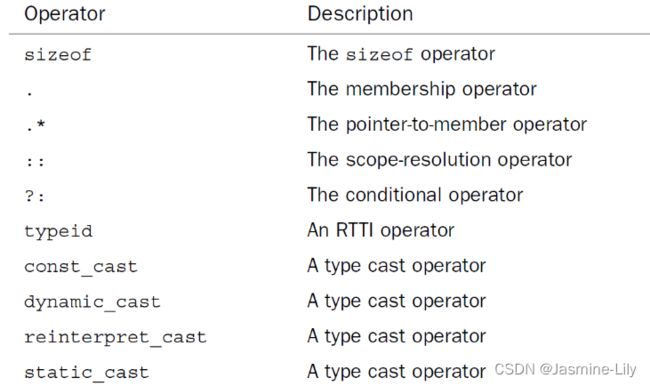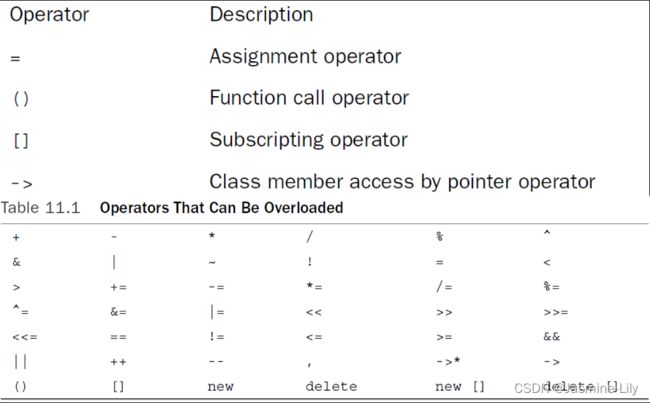C++类的运算符重载
11.8 类的运算符重载
运算符重载是一种形式的C++多态
运算符重载将充值该的概念扩展到运算符上,允许赋予C++运算符多种含义。
C++允许将运算符重载扩展到用户定义类型,例如,允许使用+将两个对象相加。
11.8.1 操作符重载定义
要重载运算符,需使用被称为运算符函数的特殊函数形式。运算符函数的格式如下:
operator op(argument-list)
例如,operator+()重载+运算符,operator*()重载*运算符。op必须是有效的C++运算符,不能虚构一个新的符号。例如,不能有operator@()这样的函数,因为C++中没有@运算符。然而,operatoe函数将重载[]运算符,因为[]是数组索引运算符。
11.8.2 调用重载的操作符
11.8.2.1 使用重载的操作符(常用)
假设有一个Salesperson类,并为它定义了一个operator+()成员函数,以重载+运算符,以便能够将两个Salesperson对象的销售额相加,如果district2, sid, and sara都是Salesperson类的对象,便可以编写这样的等式。
district2 = sid + sara;
编译器发现,操作数是Salesperson类对象,因此使用相应的运算符函数替换上述运算符。
district2 = sid.operator+(sara);
该函数将隐式地调用sid(因为它调用了方法),而显式地使用sara对象(因为他被作为参数传递)
11.8.2.2 使用operatorop()函数名
//比如这个加法
total = morefixing.operator+(total);
11.8.2.3 是否可以实现连加(or 连减、连乘…)
t4 = t1 + t2 + t3; // valid?
t4 = t1.operator+(t2 + t3); // valid?
t4 = t1.operator+(t2.operator+(t3)); // valid? YES
11.8.3 重载限制
重载的运算符(有些例外情况)不必是成员函数,但必须至少有一个操作数是用户定义的类型,以下是函数重载地限制:
1.重载后的运算符必须至少有一个操作数是用户定义的类型,这将防止用户为标准类型重载运算符。因此,不能将减法运算符(-)重载为计算两个double值的和,而是他们的差。虽然这种限制会对创造性有所影响,但可以确保程序正常运行。
2.使用运算符时不能违反运算符原来的句法规则。例如,不能将求模运算符(%)重载成为一个操作数。
int x;
Time shiva;
% x; // invalid for modulus operator
% shiva; // invalid for overloaded operator
3.不能修改运算符的优先级。因此,如果将加号运算符 重载为两个类相加,则新的运算符与原来的加号具有相同的优先级。
4.不能创建新运算符。例如,不能定义operator**()函数来表示求幂。
5.不能重载以下运算符:
6.表11.1中的大多数运算符都可以通过成员或非成员函数进行重载,但下面的运算符只能通过成员函数进行重载:
7.本章不介绍这里列出的所有运算符,但附录E对本书正文中没有介绍的运算符进行了总结。
11.8.4 举例
11.8.4.1 源代码
#pragma once
// mytime0.h -- Time class before operator overloading
#ifndef MYTIME0_H_
#define MYTIME0_H_
class Time
{
private:
int hours;
int minutes;
public:
Time();
Time(int h, int m = 0);
void AddMin(int m);
void AddHr(int h);
void Reset(int h = 0, int m = 0);
Time operator+(const Time& t) const;
Time operator-(const Time& t) const;
Time operator*(double n) const;
void Show() const;
};
#endif
// mytime0.cpp -- implementing Time methods
#include // usetime0.cpp -- using the first draft of the Time class
// compile usetime0.cpp and mytime0.cpp together
#include 11.8.4.2 运行结果
weeding time = 4 hours, 35 minutes
waxing time = 2 hours, 47 minutes
total work time = 7 hours, 22 minutes
weeding time - waxing time = 1 hours, 48 minutes
adjusted work time = 11 hours, 3 minutes
D:\Prj\C++\Function_OverLoading\Debug\Function_OverLoading.exe (进程 3524)已退出,代码为 0。
要在调试停止时自动关闭控制台,请启用“工具”->“选项”->“调试”->“调试停止时自动关闭控制台”。
按任意键关闭此窗口. . .
11.8.4.3 注意事项
不要返回指向局部变量或临时对象的引用。函数执行完毕后,局部变量和临时对象将消失,引用将指向不存在的数据。
11.8.5 重载运算符: 成员函数重载VS非成员函数重载
大多数运算符都可以通过成员或非成员函数来重载,非成员函数是友元函数,因此它可以直接访问对象的所有私有数据。
Time operator+(const Time & t) const; // member version
// nonmember version
friend Time operator+(const Time & t1, const Time & t2);
加法运算符需要两个操作数。对于成员函数版本来说,一个操作数通过this指针隐式地传递,另一个操作数作为函数参数显式地传递;对于友元版本来说,两个操作数都为参数来传递。
T1 = T2 + T3;
T1 = T2.operator+(T3); // member function
T1 = operator+(T2, T3); // nonmember function
记住,在定义运算符时,必须选择其中的一种格式,而不能同时选择这两种格式。因为这两种格式都与同一个表达式匹配,同时定义这两种格式将被视为二义性错误,导致编译错误。
那么哪种格式最好呢?对于某些运算符来说(如前所述),成员函数是唯一合法的选择。在其他情况下,这两种格式没有太大的区别。有时,根据类设计,使用非成员函数版本可能更好(尤其是为类定义类型转换时)
11.8.6 矢量类操作符重载
矢量(vector)是工程和物理中使用的一个术语,它是一个有大小和方向的量。
11.8.6.1 多种表示方式和类
可以用不同但等价的方式表示一个实体。
类非常适于在一个对象中表示实体的不同方面。首先在一个对象中存储多种表示方式;然后,编写这样的类函数,以便给一种表示方式赋值时,将自动给其他方式赋值。
11.8.6.2 为Vector类重载算数运算符
如果方法通过计算得到一个新的类对象,则应考虑是否可以使用类构造函数来完成这种工作。这样做不仅可以避免麻烦,而且可以确保新的对象时按照正确的方式创建的。
11.8.6.3 对已重载的运算符进行重载
在C++中,-运算符有两种含义;首先,使用两个操作数,它是减法运算符。减法运算是一个二元运算符,因为它有两个操作数。其次,使用一个操作数时(如-x),它是负号运算符。这种形式被称为一元运算符。即只有一个操作数。对于矢量来说,这两种操作都是有意义的,因此Vector类要有这两种操作。
因为运算符重载是通过函数来实现的,所以只要运算符函数的参数不同,使用的运算符数量与相应的内置C++运算符相同,就可以多次重载同一个运算符。
11.8.6.4 对实现的说明
Vector对象可以只存储x和y分量,而返回矢量长度的magval()方法可以根据x和y的值来计算出长度,而不是查找对象中存储的这个值。这种方法改变了实现,但用户接口不变。将接口与实现分离是OOP的目标之一,这样允许对实现进行调整,而无需修改使用这个类的程序中的代码。
一种实现是只存储直角坐标,另一种实现是存储直角坐标和极坐标。这两种实现各有利弊,存储数据意味着对象将占据更多的内存,每次Vector对象被修改时,都需要更新直角坐标和极坐标表示;但查找数据的速度比较快。如果应用程序经常需要访问矢量的这两种表示,则第二种实现比较合适;如果只是偶尔使用极坐标,则另一种更好。可以在一个程序中使用一种实现,而在另一个程序中使用另一种实现,但他们的用户接口相同。
11.8.6.5 一个实例–使用Vector类模拟随机漫步
将一个人领到一个街灯柱下,这个人开始走动,但每一步的方向都是随机的。提出的问题是:这个人走到离灯柱50英尺处需要多少步,从矢量的角度看,这相当于不断将方向随机的矢量相加,直到长度超过50英尺。
11.8.6.5.1 code
#pragma once
//添加命名空间是为了复习之前命名空间的内容
// vect.h -- Vector class with <<, mode state
#ifndef VECTOR_H_
#define VECTOR_H_
#include // vect.cpp -- methods for the Vector class
#include // randwalk.cpp -- using the Vector class
// compile with the vect.cpp file
#include 这个程序用一个变量来表示位置(一个矢量),并报告到达只当距离处(用两种格式表示)所需的步数。
11.8.6.5.2 程序笔记
标准ANSI C库(C++也有)中有一个rand()函数,它返回一个从0到某个值之间的随机整数。上述程序使用求模操作数来获得一个0~359的角度值。rand()函数将一种算法用于一个初始种子值来获得随机数,该随机数将用作下一次函数调用的种子。这些数实际上是伪随机数,因为10次连续的调用通常将生成10个同样的随机数。然而,srand()函数允许覆盖默认的种子值,重新启动从某一个随机数序列,该程序使用time(0)的返回值来设置种子。time(0)函数返回当前时间,通常为从某一个日期开始的秒数(更广义的,time()接受time_t变量的地址,将时间放到该变量中,并返回它。将0用作地址参数,可以省略time_t变量声明)。因此,下面的语句在每次运行程序时,都将设置不同的种子,使随机输出看上去更为随机。
srand(time(0));
头文件cstdlib(以前为stdlib.h)包含了srand()和rand()的原型,而ctime(以前是time.h)包含了time()的原型。C++11使用头文件random中的函数提供了更强大的随机数支持。

